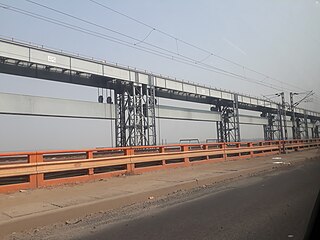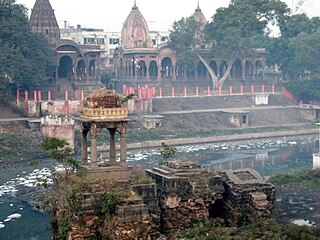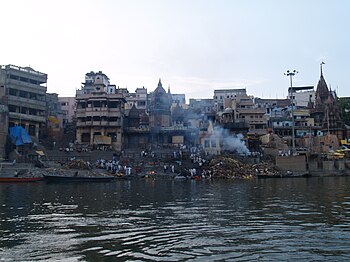
The Ganges is a trans-boundary river of Asia which flows through India and Bangladesh. The 2,525 km (1,569 mi)-long river rises in the western Himalayas in the Indian state of Uttarakhand. It flows south and east through the Gangetic plain of North India, receiving the right-bank tributary, the Yamuna, which also rises in the western Indian Himalayas, and several left-bank tributaries from Nepal that account for the bulk of its flow. In West Bengal state, India, a feeder canal taking off from its right bank diverts 50% of its flow southwards, artificially connecting it to the Hooghly River. The Ganges continues into Bangladesh, its name changing to the Padma. It is then joined by the Jamuna, the lower stream of the Brahmaputra, and eventually the Meghna, forming the major estuary of the Ganges Delta, and emptying into the Bay of Bengal. The Ganges–Brahmaputra–Meghna system is the second-largest river on earth by discharge.

The Yamuna is the second-largest tributary river of the Ganges by discharge and the longest tributary in India. Originating from the Yamunotri Glacier at a height of about 4,500 m (14,800 ft) on the southwestern slopes of Bandarpunch peaks of the Lower Himalaya in Uttarakhand, it travels 1,376 kilometres (855 mi) and has a drainage system of 366,223 square kilometres (141,399 sq mi), 40.2% of the entire Ganges Basin. It merges with the Ganges at Triveni Sangam, Allahabad, which is a site of the Kumbh Mela, a Hindu festival held every 12 years.

The Sabarmati River is one of the major west-flowing rivers in India. It originates in the Aravalli Range of the Udaipur District of Rajasthan and meets the Gulf of Khambhat of Arabian Sea after travelling 371 km (231 mi) in a south-westerly direction across Rajasthan and Gujarat. 48 km (30 mi) of the river length is in Rajasthan, while 323 km (201 mi) is in Gujarat.

The Gomti, Gumti or Gomati River is a tributary of the Ganges. According to Hindu belief, the river is the daughter of Rishi Vashishtha and bathing in the Gomti on Ekadashi can wash away sins. According to the Bhagavata Purana, one of Hinduism's major religious works, Gomti is one of the five transcendental rivers of India. The rare Gomti Chakra is found there.

Farakka Barrage is a barrage across the Ganga river located in Murshidabad district in the Indian state of West Bengal, roughly 18 kilometres (11 mi) from the border with Bangladesh near sahibganj. Farakka Barrage Township is located in Farakka in Murshidabad district. Construction of the barrage started in 1962, and was completed in 1970 at a cost of $208 million. It became operational on 21 April 1975. The barrage is about 2,304 metres (7,559 ft) long. The Feeder Canal (Farakka) from the barrage to the Bhagirathi-Hooghly River is about 42 km (26 mi) long.
Sankat Mochan Foundation (SMF) is a non-governmental organization devoted to cleaning the pollution of the Ganges and protecting the Ganges river in India. The environmental mission is related to the religious mission of Sankat Mochan Temple and Late Veer Bhadra Mishra was manager of both organizations. Mishra was awarded the United Nations Environment Programme's (UNEP) the "Global 500 Roll of Honour" in 1992, The foundation has been working with Australia-based environmental group, Oz Greene, under a program called "Swatcha Ganga Abhiyan" for over 38 years. It celebrated its silver jubilee on 3–4 November 2007, with two-day event which concluded at the Tulsi Ghat, on the Ganges.

Water resources in India includes information on precipitation, surface and groundwater storage and hydropower potential. India experiences an average precipitation of 1,170 millimetres (46 in) per year, or about 4,000 cubic kilometres (960 cu mi) of rains annually or about 1,720 cubic metres (61,000 cu ft) of fresh water per person every year. India accounts for 18% of the world's population and about 4% of the world's water resources. One of the proposed solutions to solve the country's water woes is the Indian rivers interlinking project. Some 80 percent of its area experiences rains of 750 millimetres (30 in) or more a year. However, this rain is not uniform in time or geography. Most of the rains occur during its monsoon seasons, with the northeast and north receiving far more rain than India's west and south. Other than rains, the melting of snow over the Himalayas after the winter season feeds the northern rivers to varying degrees. The southern rivers, however, experience more flow variability over the year. For the Himalayan basin, this leads to flooding in some months and water scarcity in others. Despite an extensive river system, safe clean drinking water as well as irrigation water supplies for sustainable agriculture are in shortage across India, in part because it has, as yet, harnessed a small fraction of its available and recoverable surface water resource. India harnessed 761 cubic kilometres (183 cu mi) (20 percent) of its water resources in 2010, part of which came from unsustainable use of groundwater. Of the water it withdrew from its rivers and groundwater wells, India dedicated about 688 cubic kilometres (165 cu mi) to irrigation, 56 cubic kilometres (13 cu mi) to municipal and drinking water applications and 17 cubic kilometres (4.1 cu mi) to industry.
The Ministry of Water Resources, River Development and Ganga Rejuvenation was the apex body for formulation and administration of rules and regulations relating to the development and regulation of the water resources in India. The Ministry was formed in January 1985 following the bifurcation of the then Ministry of Irrigation and Power, when the Department of Irrigation was re-constituted as the Ministry of Water Resources. In July 2014, the Ministry was renamed to “Ministry of Water Resources, River Development & Ganga Rejuvenation”, making it the National Ganga River Basin Authority for conservation, development, management, and abatement of pollution in the river Ganges and its tributaries. In May 2019, this ministry was merged with the Ministry of Drinking Water and Sanitation to form the Ministry of Jal Shakti.
The Ganges Barrage, officially named as the Lav Khush Barrage, this bridge across the Ganges river lies at Azad Nagar-Nawabganj in Kanpur.

Guru das Agrawal, also known as Sant Swami Sanand and Sant Swami Gyan Swaroop Sanand, was an Indian environmentalist, engineer, religious leader, monk, and professor. He was the Patron of Ganga Mahasabha, founded by Madan Mohan Malviya in 1905.
National Ganga River Basin Authority (NGRBA) is a financing, planning, implementing, monitoring and coordinating authority for the Ganges River, functioning under the Ministry of Jal Shakti, of India. The mission of the organisation is to safeguard the drainage basin which feeds water into the Ganges by protecting it from pollution or overuse. In July 2014, the NGRBA was transferred from the Ministry of Environment and Forests to the Department of Water Resources, River Development & Ganga Rejuvenation, formerly the Ministry of Water Resources (India).

Water pollution is a major environmental issue in India. The largest source of water pollution in India is untreated sewage. Other sources of pollution include agricultural runoff and unregulated small-scale industry. Most rivers, lakes and surface water in India are polluted due to industries, untreated sewage and solid wastes. Although the average annual precipitation in India is about 4000 billion cubic metres, only about 1122 billion cubic metres of water resources are available for utilization due to lack of infrastructure. Much of this water is unsafe, because pollution degrades water quality. Water pollution severely limits the amount of water available to Indian consumers, its industry and its agriculture.
Save Ganga Movement is a widespread Gandhian non-violent movement supported by saints and popular social activists across the Indian States Uttar Pradesh and Bihar in support of a free Ganga. The movement is supported by Ganga Seva Abhiyanam, Pune-based National Women's Organisation (NWO) besides those of many other like-minded organisations and with the moral support from many religious leaders, spiritual and political, scientists, environmentalists, writers and social activists. Ganga Calling – Save Ganga is another such campaign supported by Indian Council for Enviro-Legal Action (ICELA).

The Sahibi river, also called the Sabi River, is an ephemeral, rain-fed river flowing through Rajasthan, Haryana and Delhi states in India. It originates in the eastern slopes of the Saiwar Protected Forest (PF) hills in Sikar District, enters Jaipur district near the foot of these hills, and after initially flowing southeast and east turns northeastwards near Shahpura and continues further till it exits Rajasthan to enter Haryana and further drains into Yamuna in Delhi, where its channeled course is also called the Najafgarh drain, which also serves as Najafgarh drain bird sanctuary. It flows for 300 km of which 157 km is in Rajasthan 100 km is in Haryana and 40 km in Delhi.
Water scarcity in India is an ongoing water crisis that affects nearly hundreds of million of people each year. In addition to affecting the huge rural and urban population, the water scarcity in India also extensively affects the ecosystem and agriculture. India has only 4% of the world's fresh water resources despite a population of over 1.4 billion people. In addition to the disproportionate availability of freshwater, water scarcity in India also results from drying up of rivers and their reservoirs in the summer months, right before the onset of the monsoons throughout the country. The crisis has especially worsened in the recent years due to climate change which results in delayed monsoons, consequently drying out reservoirs in several regions. Other factors attributed to the shortage of water in India are a lack of proper infrastructure and government oversight and unchecked water pollution.

The Ganges Barrage Project was a proposed project in Bangladesh to hold back rain water of the monsoon season because of the periodic drying up of the Ganges River in Bangladesh due to the Farakka Barrage. It was formally cancelled in 2017.

Kanh is a river flowing through Indore, the largest city in the Indian state of Madhya Pradesh. The river started carrying sewage in the early 1990s. Several attempts have been made to clean the river, yet it remains polluted.
The Palla barrage is a barrage located in Palla on the Yamuna-Faridabad canal in Faridabad district of Haryana state in India. This irrigation canal runs to the west of Yaumna through Fridabad, Palwal, Mathura and Agra districts where it terminates in the farms. Palla, Faridabad is not to be confused with Palla, Delhi, a Yamuna pollution monitoring station 23 km upstream of Wazirabad barrage.

The Ministry of Jal Shakti is a ministry under Government of India which was formed in May 2019 under the second Modi ministry. This was formed by merging of two ministries; Ministry of Water Resources, River Development and Ganga Rejuvenation and Ministry of Drinking Water and Sanitation.
Namami Gange Programme is an Integrated Conservation Mission, approved as a Flagship Programme by the Union Government of India in June 2014 with a budget outlay of ₹22,500 crore from 2023–26 to accomplish the twin objectives of effective abatement of pollution, conservation and rejuvenation of National River Ganga. It aimed at engaging with the community which will connect various interest groups including Scientists, Technology companies, Investors and community members. NMCG has decided to declare Chacha Chaudhary the popular comic book character, as the mascot of the Namami Gange Programme a statement issued by the Ministry of Jal Shakti. Under the Namami Gange Programme, all the drains falling into the river Saryu in the religious and historical city of Ayodhya are being tapped and contaminated water is being transported to the sewerage treatment plant. The research division of Namami Gange is led by CGanga, established under the aegis of IIT Kanpur.















